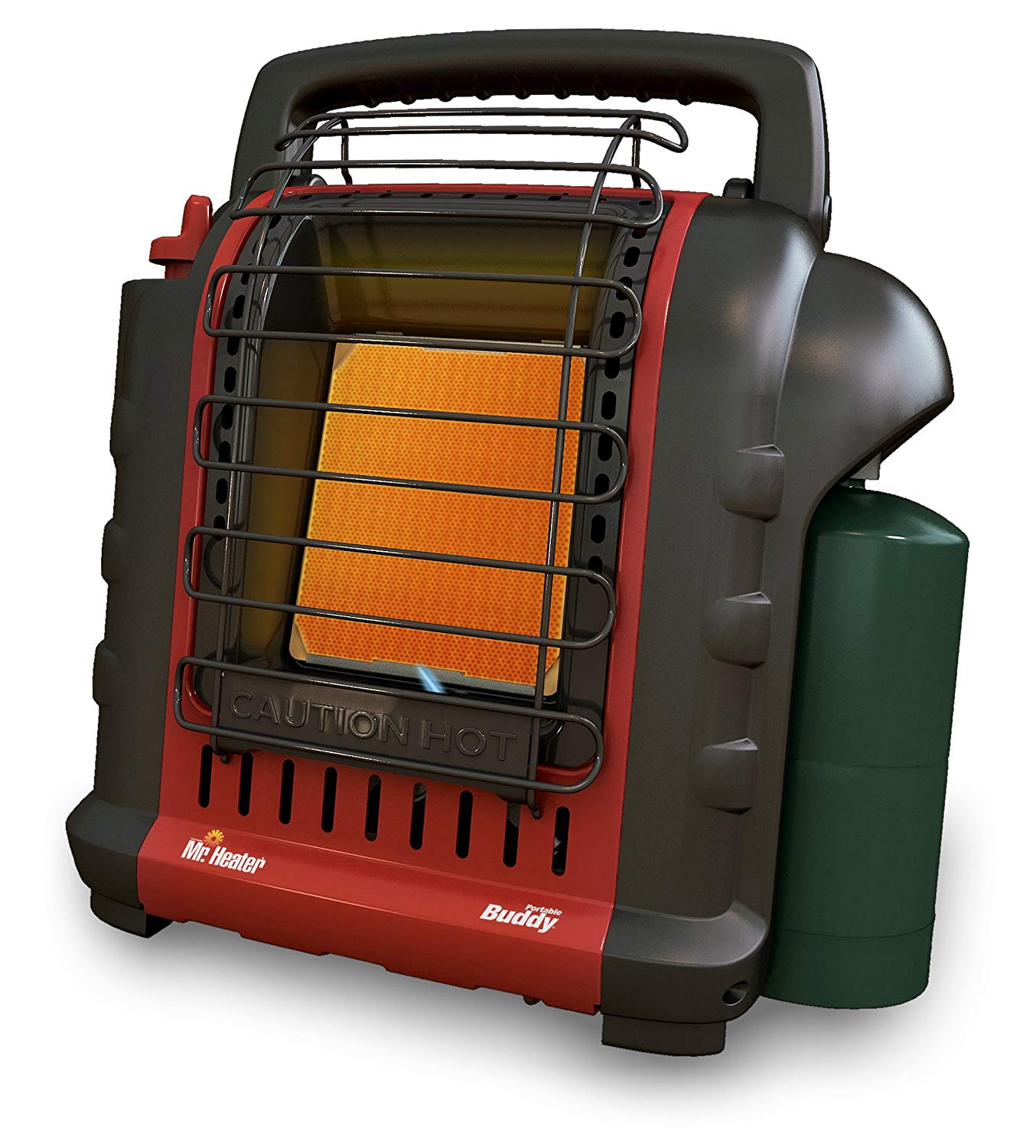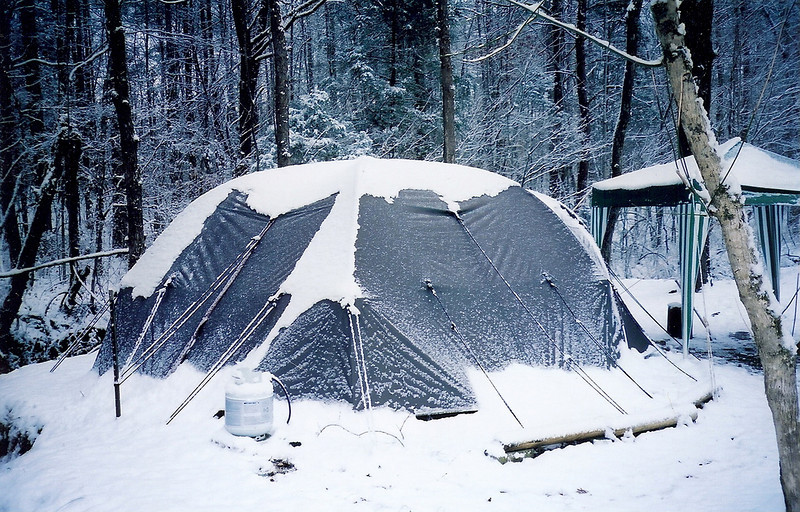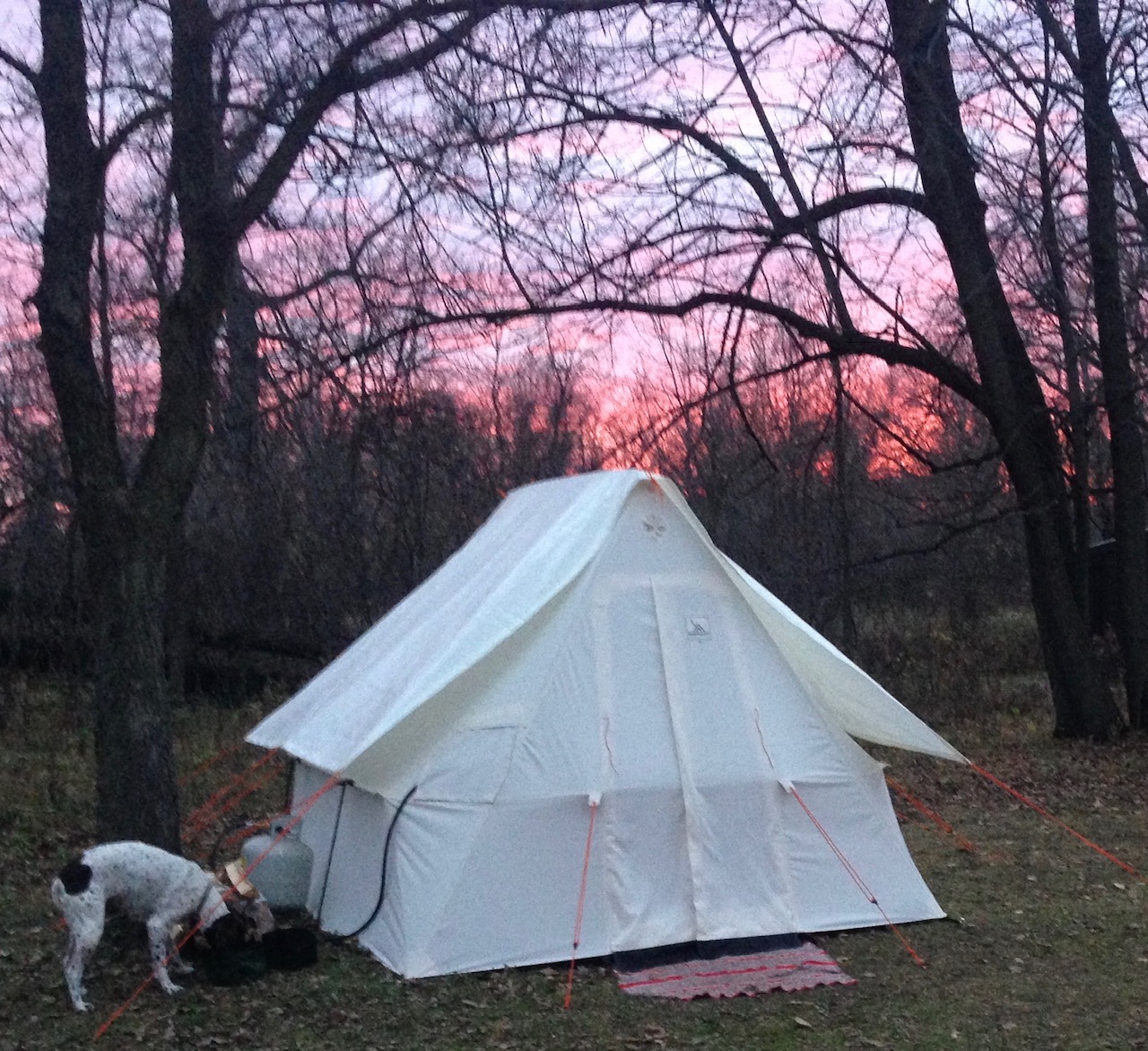Topic
Advice on Propane Heater for Car Camping Tent
Forum Posting
A Membership is required to post in the forums. Login or become a member to post in the member forums!
Home › Forums › Gear Forums › Gear (General) › Advice on Propane Heater for Car Camping Tent
- This topic has 21 replies, 12 voices, and was last updated 5 years, 3 months ago by
 Tipi Walter.
Tipi Walter.
-
AuthorPosts
-
Dec 20, 2018 at 4:21 pm #3569575
We were considering spending a few days in Yosemite Valley in a heated canvas tent cabin, then it occurred to us we could car camp instead and bring a heater similar to below. Thoughts? Note that the description says the heater is “safe” for indoor use.

Product Description (from Amazon)
F232025 Californa Buddy Mr. Heater offers the latest evolution in portable heating with the Portable Buddy Propane Heater. Use it in garages, tents, workshops, cabins, porches, patios, or hunting blinds to heat up to 200 sq. ft. Equipped with a low-oxygen shut-off pilot system and accidental tip-over shutoff for safety and features low/high heat settings of 4,000 and 9,000 BTU/hr. allowing you to control comfort level.Accidental tip-over safety shutoff.Lightweight, easy to carry.Heats up to 200 sq. ft..Connects directly to a 20 lb. propane cylinder with optional hose (propane not included).Low/High heat settings of 4,000 and 9,000 BTU/hr..Size: L 14.25 x W 9″ x H 14.25″.Dec 20, 2018 at 5:31 pm #3569590Those heaters can have very low CO emissions. But even with no CO emissions, they will still use up oxygen. A minivan is what, 10 feet long on the inside, 4-5 feet across and 4 feet high? 200 cubic feet at most. The pound of propane in that little cylinder occupies 8.4 cubic feet as a gas (at 1 atm pressure). 8.4 cubic feet of propane needs (the oxygen in) 8.4 x 23.8 = 200 cubic feet or air (I did not cook those numbers, I just estimated the volume of the van and run the calc). Plus the humans use some oxygen. So, without windows being cracked and giving some ventilation, you’re now relying on their “low-oxygen shut-off pilot system” or you’ll be dead. I’m not sure how that shut-off system works, but it’s not using a O2-sensing cell like I would when entering a potentially low-oxygen environment. If the low-oxygen shut-off works, you then do what? Wake up cold two hours later, open a window for a while, restart the heater, and wash, rinse, repeat?
My suggestion: Just run the van’s motor and climate system. The engine gets warm, the coolant gets warm, the heater core heats the interior air (just like when you’re driving the car), you never breath the exhaust of a flame and none of the air in the van is used for combustion. And there is some fresh air being brought in. I do that A LOT – many nights a year over the last 40 years, and it takes 1/4 gallon per hour for a 4-cylinder engine to idle. 2 gallons a night. About $7. A lot cheaper than a hotel room. In a modern car, I don’t fret about anything. In old cars without good emission controls, like I used to drive, I’d assess the wind conditions and park with the tailpipe down wind, so as not to entrain any (minimal amount of) exhaust back to the fresh-air intake.
Snow camping in your vehicle – it is far more weather-proof than any tent (easily handles 90+ mph winds), you can set it for whatever temperature you want*, charge your phone, and listen to tunes.
*I was driving up the Alcan in January 1999 in a Toyota Camry and discovered it could maintain 100F over ambient. Which sounds fine – cabin temp of 100F when it is 0F outside. But it was -44F outside. 56F is, yeah, nice hiking weather, but when you’re NOT hiking and just sitting for hours and hours, right next to sub-zero glass, it’s pretty cold even with insulated overalls on.
Dec 20, 2018 at 8:13 pm #3569610Thanks David, I was hoping you would reply. I’ve read “sleeping in running car” posts before but for some reason it didn’t occur to me.
I’m not sure all 4 of us would fit in the Mazda 5. However, maybe the wife and 1 kid can be in the car and I would be out in the tent (without heater) with another kid.
Thanks again.
Dec 20, 2018 at 8:36 pm #3569613I think that’s a catalytic heater?
They put out a lot of water vapor. Inside of windows become covered in condensation. High humidity inside. In my experience.
Dec 20, 2018 at 9:16 pm #3569617Every year it seems their are news stories of hunters and campers in camper vehicles dying of carbon monoxide poisoning.
IF you decide to buy a catalytic heater also buy a battery operated CO alarm. would not use a catalytic heater in any enclosed space including my home without an alarm.
Dec 20, 2018 at 10:14 pm #35696275 of us ended up “sleeping” in a compact British car one night we couldn’t find any lodging. We didn’t sleep much. We did better for the 2017 eclipse south of Portland with 4 of us, our daughter’s friend and an exchange student in a rental mini van. Ideally, everyone has their own reclining seat, their own pillow and no one snores.
Hitchhiker’s Guide to the Galaxy claims that the most important item to pack is a towel. Towels are good to have on road trips, but a full-size pillow – one that’s you’ve taken off your regular bed at home – is more important.
Dec 20, 2018 at 10:16 pm #3569628I agree with Eric and was going to mention alarms before I went down the just-idle-the-car path. If you are going to run a heater in an enclosed space, use a battery-operated CO alarm. They’re now mass-produced, readily available and cheap $10-$20 at Walmart or Home Depot. But that doesn’t solve the low-oxygen problem. A very efficient catalytic heater could still be running, without making CO, down below 10% O2 (down from 20.8% in the atmosphere) and unless you’re a Sherpa or otherwise acclimatized to low O2 partial pressures, you might not wake up to the alarm sound.
While that heater claims to shut off for low O2, I’d want to test it first – say, running it in an a closed vehicle and see how low the O2 gets before it shuts off. I have instruments for that, or you could just use your least-favorite pet or in-law as an organic O2 sensor.
Dec 20, 2018 at 11:55 pm #3569648If I need to keep the car warm, I will run the engine. If sleeping without motor running, I like having side window deflectors, which would allow you to crack the windows and have some airflow, and keep rain off. Not sure this would suffice for a heater though.
Two kinds sold, ones that glue to the window frame and ones that insert inside the weatherstripping. I prefer the latter. I have had good luck with Weather Tech ones. Pricey, but we buy new cars and keep for 15 years or more.
Dec 21, 2018 at 5:42 pm #3569715These heaters work great in tents. I’ve used this exact one many times. Just make sure you have some air flow by keeping vents open and crack the door if needed. Also be sure to keep it protected from being knocked over. The heater will turn off but the grate is still hot.
Running your car all night in a Yosemite Valley campground is definitely a no go. Not only rude to neighbors but I’m certain you’d get shut down by a ranger or the campground host.
Dec 21, 2018 at 7:48 pm #3569730Casey,
I have a couple catalytic heaters and they work great. My recommendation would be to sleep with lots of insulation and just fire that up with open windows when people are awake and out of their sleeping bags so you can keep an eye on things.
Dec 21, 2018 at 10:04 pm #3569745“Running your car all night in a Yosemite Valley campground is definitely a no go”
Yeah, especially in the summer, the Rangers are looking for stealth / car campers. I often stay just outside the Big Oak Flat Road / Highway 120 entrance (1 mile before the entrance kiosk) then north on Evergreen Road (towards Hetch Hetchy). There’s a USFS campground at the bottom of the first slope along the creek.
https://s3.amazonaws.com/static-myyosemitepark/public/YO-official-map_NPS.pdf
Dec 24, 2018 at 2:52 am #3569904According to the van camper life people, the Mr. Heater Buddy tends to run very hot for small spaces, which forces you to turn it off….then it gets cold, you turn it back on….a bit of cycling.
Also, the long term reliability has come into question.
The Olympian is consider a better solution for the van, but more expensive.
https://www.youtube.com/watch?v=fPXRCANYxEU
https://www.youtube.com/watch?v=Dx3-h8EjfjI
Above are some videos for you.
Tony
Dec 25, 2018 at 6:25 am #3570036- DANGER!
Bear in mind that if you run such a heater overnight in a closed up van or tourist tent (to keep the cold out), you may not wake up in the morning. People have done this and died from CO poisoning.
Cheers
Jan 1, 2019 at 2:04 pm #3570943I’ve been searching for a propane heater for my squaredrop (teardrop) trailer and I’ve run across a brand called Propex Heaters. They don’t have the CO problem and they remove moisture. Everything sounds good but the price as there quite expensive but reviews have been really good. Some people buy them and mount them in a tool box for portability versus a fixed traditional permanent mounting. The link below already shows one you can buy mounted to a box. I have read blogs where people have rigged these up so they can use them in a roof top tent too.
http://store.adventuretrailers.com/copy-of-portable-furnace-heatsource-hs2000/
Jan 1, 2019 at 3:19 pm #3570949I used a Mr Buddy heater for several years in a Cabelas Xtreme Weather Tent and think I have pics of my set up on Chickasaw Creek in TN. I agree with Tyler—they work great.

Here’s my set up in 2004-2006 with the Mr Buddy hooked up to a 20 lb propane tank with an extra long hose. I’m used to using woodstoves in my primitive structures (tipis, wigwams) but had to make allowances for this Xtreme weather Cabelas tent.

This pic better shows the tank.

This shows the 12×12 tent layout with the heater and tank.
Jan 1, 2019 at 3:19 pm #3570950Interesting. Folks out there are buying this kit and mounting inside a box?
$845.00 kit
 Jan 1, 2019 at 3:35 pm #3570951
Jan 1, 2019 at 3:35 pm #3570951The Propex system (above) requires voltage and electricity—while the Mr Buddy does not. And the propex system is vented outside—while the Buddy has a turn-off sensor when indoor oxygen levels get low.
Due to the limited amount of propane at a campsite (versus cords of wood to feed a woodstove at other sites)—I never left my Buddy heater on all night—my ample subzero down bag became my heater thru the night. But it was left on hours at a time and provided warmth when needed.
Jan 1, 2019 at 4:03 pm #3570956Tipi, here is what is said about the Propex:
The Portable Heater is designed to be used outside. As the outer box has access holes it’s best to locate the heater in an area out of the direct path of rain, sleet, and snow.
The portable unit comes with 5 feet of UV stable, “harsh environment” flex ducting to direct hot air from the furnace into your tent. The intake air can either be drawn into the furnace from the outside, or add another section of flex duct and drawn the return air from the tent for more efficient heating.
Jan 1, 2019 at 4:36 pm #3570958I think some like to mount the Propex in a box because they don’t always need to bring it with or they don’t have the room all the time or maybe a place to permanently mount it?
The Propex air doesn’t smell like propane like the buddy heater does, also removes moisture where the buddy adds moisture to the air.
In mentioning the Propex Heater I wasn’t sure if they were camping in a tent or car for “car camping”.
If using a tent nearby a vehicle I agree with Tipi and Tyler where I would choose propane and use the buddy heater. I have used this setup for years when I go out pheasant hunting. Snowtrekker EXP Basecamp 9.5×11. Weighs 26# but so much more comfortable for an extended stay car camping.

Edit: If your using the Buddy heater with a refillable tank like the 10 or 20#, it’s a good idea to use the screw on in-line filter that MrHeater sells. It will help with the longevity of the heater.
I also recommend hanging a fan at the roof aiming down to push the heat back down to the ground.
Jan 1, 2019 at 4:55 pm #3570961Things can and will go wrong with LP heaters in a tent or vehicle:
Dangerous and doesn’t last.
By BlueBellBlue on May 17, 2017
Dangerous and doesn’t last. This is my second one of these. The first one caught on fire where are the propane bottle screws in at the Grand Canyon. Thankfully I was able to get it outside of the RV before anything else caught on fire and hit it with the fire extinguisher. I didn’t want another one, but sometimes when it’s cold you need a propane heater and the built-in one uses too much electricity for the fan plus it’s just too damn noisy. So many people swear by this heater that I thought maybe I had a dud and I went for another one. But no, here I am in freezing temperatures near Zion national Park and the heater does not want to light. With a brand-new full propane cylinder. However, I have learned my lesson and after three attempts I’m not trying anymore. Because I’m tired of going through fire extinguishers. I’m tossing this piece of crap tomorrow and simply moving to warmer temperatures. It’s just not worth the risk. Jan 1, 2019 at 8:23 pm #3570986
Jan 1, 2019 at 8:23 pm #3570986I never liked using those little green propane tanks with my Buddy heater and instead favored the long hose with an outside 20 lb tank. The bad review might have come from not getting the green propane tank screwed in properly. The hose may in fact connect tighter and better. I never had any problems with the thing.
I don’t consider the Buddy heater to be a top of the line item like a Hilleberg tent but it’s widely available at hardware stores. On the other hand, an indepth google search could probably find a Buddy-type heater of much higher quality.
I share JP’s experience—it’s worked for us.
Another option is to go the hot tent route with a woodstove, something I am very familiar with. Before I went the Xtreme weather tent with Buddy heater I built a small 14 foot diameter wigwam (shaped like a large sweat lodge with saplings) and used a woodstove for heat. (Before that I lived in a woodstove heated Tipi for 21 years etc).
Here’s my little Witu in action (aka wigwam)—(check out the stove pipe coming out the side)—
 Jan 1, 2019 at 8:28 pm #3570987
Jan 1, 2019 at 8:28 pm #3570987FOOTNOTE POST—When things get tough a woodstove’s the way to go!! (Just getting “home” and preparing to fire up the stove).

-
AuthorPosts
- You must be logged in to reply to this topic.
Forum Posting
A Membership is required to post in the forums. Login or become a member to post in the member forums!
Our Community Posts are Moderated
Backpacking Light community posts are moderated and here to foster helpful and positive discussions about lightweight backpacking. Please be mindful of our values and boundaries and review our Community Guidelines prior to posting.
Get the Newsletter
Gear Research & Discovery Tools
- Browse our curated Gear Shop
- See the latest Gear Deals and Sales
- Our Recommendations
- Search for Gear on Sale with the Gear Finder
- Used Gear Swap
- Member Gear Reviews and BPL Gear Review Articles
- Browse by Gear Type or Brand.











